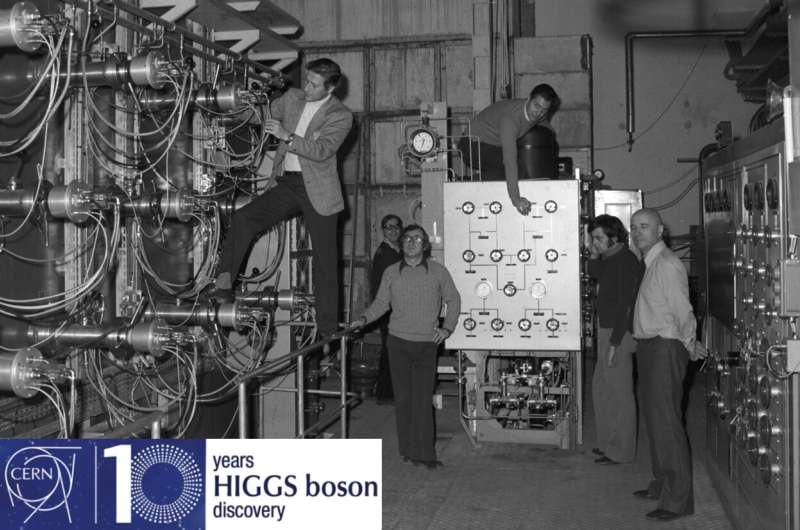The Higgs boson and the rise of the standard model of particle physics in the 1970s

At the dawn of the 1970s, the idea of a massive scalar boson as the keystone of a unified theoretical model of the weak and electromagnetic interactions had yet to become anchored in a field that was still learning to live with what we now know as the standard model of particle physics. As the various breakthroughs of the decade gradually consolidated this theoretical framework, the Brout–Englert–Higgs (BEH) field and its boson emerged as the most promising theoretical model to explain the origin of mass.
In the 1960s, there were remarkably few citations of the papers by Sheldon Glashow, Abdus Salam and Steven Weinberg on the theory of unified weak and electromagnetic interactions. All that changed, however, in 1971 and 1972 when, in Utrecht, Gerard 't Hooft and Martinus Veltman (a former CERN staff member) proved that gauge theories employing the Brout-Englert-Higgs mechanism to generate masses for gauge bosons are renormalizable, and hence are mathematically consistent and can be used to make reliable, precise calculations for the weak interactions. This breakthrough was given broad publicity in an influential talk by Benjamin Lee of Fermilab during the ICHEP conference held there in 1972, in which he talked at length about "Higgs fields."
Encouraged, in particular, by the CERN theorists Jacques Prentki and Bruno Zumino, the Gargamelle collaboration prioritized the search for weak neutral current interactions in the CERN neutrino beam, and their representative Paul Musset presented the first direct evidence for them in a seminar at CERN on 19 July 1973. This first experimental support for the unification of the electromagnetic and weak interactions attracted great interest and close scrutiny, but was generally accepted within a few months. The neutral-current discovery convinced physicists that the nascent standard model was on the right track. Former CERN Director-General Luciano Maiani, quoted in a 2013 CERN Courier article, puts it this way: "At the start of the decade, people did not generally believe in a standard theory, even though theory had done everything. The neutral-current signals changed that. From then on, particle physics had to test the standard theory."
The next breakthrough came in 1974, when two experimental groups working in the United States, led by Sam Ting at Brookhaven and Burt Richter at SLAC, discovered a narrow vector resonance, the J/psi, with prominent decays into lepton–antilepton pairs. Many theoretical interpretations were proposed, which we at CERN discussed over the phone in excited midnight seminars with Fred Gilman at SLAC (almost 40 years before Zoom!). The winning interpretation was that the J/psi was a bound state of the charm quark and its antiquark. The existence of this fourth quark had been proposed by James Bjorken and Sheldon Glashow in 1964, and its use to suppress flavor-changing neutral weak interactions had been proposed by Glashow, John Iliopoulos and Maiani in 1970. Mary K. Gaillard (a long-term visiting scientist at CERN), Jon Rosner and Lee wrote an influential paper on the phenomenology of charm in 1974, and experiments gradually fell into line with their predictions, with final confirmation coming in 1976.
The attention of most of the theoretical and experimental communities was then drawn towards the search for the massive W and Z vector bosons responsible for the weak interactions. This motivated the construction of high-energy hadron colliders and led to the discovery of the W and Z bosons at CERN in 1983 by a team led by Carlo Rubbia.
However, it seemed to Mary K. Gaillard, Dimitri Nanopoulos and myself at CERN that the key question was not the existence of the massive weak vector bosons, but rather that of the scalar Higgs boson that enabled the standard model to be physically consistent and mathematically calculable. At the time, the number of papers on the phenomenology of the Higgs boson could be counted on the fingers of one hand, so we set out to describe its phenomenological profile in some detail, covering a wide range of possible masses. Among the production mechanisms we considered was the possible production of the Higgs boson in association with the Z boson, which generated considerable interest in the days of LEP 2. Among the Higgs decay modes we calculated was that into a pair of photons. This distinctive channel is particularly interesting because it is generated by quantum effects (loop diagrams) in the standard model.
Despite our conviction that something like the Higgs boson had to exist, our paper ended on a cautionary note that was somewhat tongue-in-cheek: "We apologize to experimentalists for having no idea what is the mass of the Higgs boson … and for not being sure of its couplings to other particles, except that they are probably all very small. For these reasons we do not want to encourage big experimental searches for the Higgs boson, but we do feel that people performing experiments vulnerable to the Higgs boson should know how it may turn up."
This caution was in part because the senior physicists of the day (Dimitri and I were under 30 at the time) regarded the ideas surrounding electroweak symmetry breaking and the Higgs boson with rather jaundiced eyes. Nevertheless, as time went on, the massive W and Z were discovered, the existence or otherwise of the Higgs boson rose up the experimental agenda, and no plausible alternative theoretical suggestions to the existence of something like the Higgs boson emerged. Experimentalists, first at LEP and later at the Tevatron and the LHC, focused increasingly on searches for the Higgs boson as the final building block of the standard model, culminating in the discovery on 4 July 2012.
Provided by CERN




















